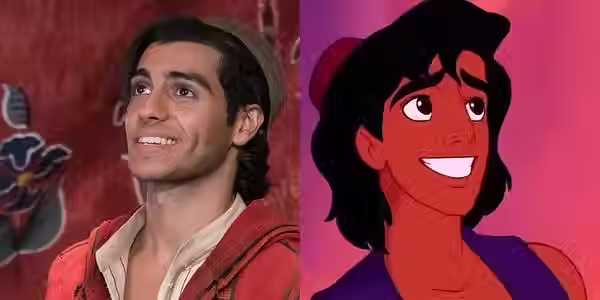Fan Reaction Video
Aladdin has changed a lot throughout the years, watch as a fan reacts to these differences!
Design rationale
In developing my reaction video, my intention was to critically examine the significant narrative and character changes introduced in the 2019 remake of Aladdin, particularly those that stood out unexpectedly. As an admirer of the original film, I was notably intrigued by how the remake redefines the character of Princess Jasmine, enriching her narrative depth by portraying her as empowered, ambitious, and complex. Consequently, my creative artifact centers specifically on the film’s representation of women, with a particular emphasis on Jasmine’s character development. To effectively communicate my reaction, I employed varied editing styles and screen layouts, including a prominent display of key scenes from the film accompanied by my reactions in a smaller, rounded frame positioned to the side, as well as a simultaneous split-screen format. Furthermore, by presenting myself as an avatar rather than using my personal image, I aimed to underscore that this perspective is representative of a broader community of Aladdin fans, reinforcing the universality and accessibility of fan engagement.
Creative Workflow & Avatar Creation
As a fan of Aladdin, I incorporated visual elements inspired by the film’s character costumes into my reaction video, specifically focusing on the distinctive rounded hat. By selecting an avatar that features a similar hat shape, I sought to enhance visual coherence and thematic relevance. This choice not only enriches the reactor figure aesthetically but also makes the avatar more engaging and relatable to the audience, thereby strengthening viewer connection and interaction throughout the video.


Documentation
1. The software I used for editing my reaction video was CapCut, which allows me to edit my video by switchover scenes, extracting audios, and different layout design of screening, aiding me to better emphasize female representation that the scenes wanting to express.
Initially, I selected relevant video clips from my completed recordings and imported them into the CapCut editing application. Subsequently, I arranged these clips sequentially to ensure each reaction aligned accurately with corresponding scenes from the film. Additionally, I extracted audio from the original recordings, synchronizing it precisely with both the reactions and the film scenes, thus creating a cohesive and integrated final video.

2. To ensure clarity and prevent visual overlap between the reaction footage and the selected key scenes from the film, I edited my reaction recordings into a smaller, rounded frame positioned at the lower left-hand side of the main video.
This placement facilitates immediate and clear viewing of reactions in direct relation to corresponding scenes, while simultaneously ensuring the primary film content remains unobstructed and fully visible. This approach effectively maintains audience engagement by providing simultaneous access to both reaction and film content without visual interference.

3. Additionally, I incorporated pop-up visual effects in which images appear suddenly during key moment where comparting the two version of Aladdin of the reaction video. This technique enhances viewer engagement by introducing dynamic and visually stimulating elements. Moreover, these strategically placed pop-up visuals enrich the narrative context, providing deeper and more compelling imagery. This approach helps prevent boredom and adds depth to the reactions shown.

4. Lastly, I included a trailer reaction video at the conclusion of my project. As a fan, my primary intention was to introduce and recommend this remarkable film to others. By providing a genuine reaction to a trailer that I had not previously seen, my aim was to authentically encourage viewers to watch the film. For this segment, I utilized a vertical split-screen format, positioning my reaction footage directly below the trailer. This layout allows viewers to simultaneously observe the trailer content and my real-time reactions, clearly emphasizing the connection between the scenes being presented and the emotional or analytical responses elicited.
